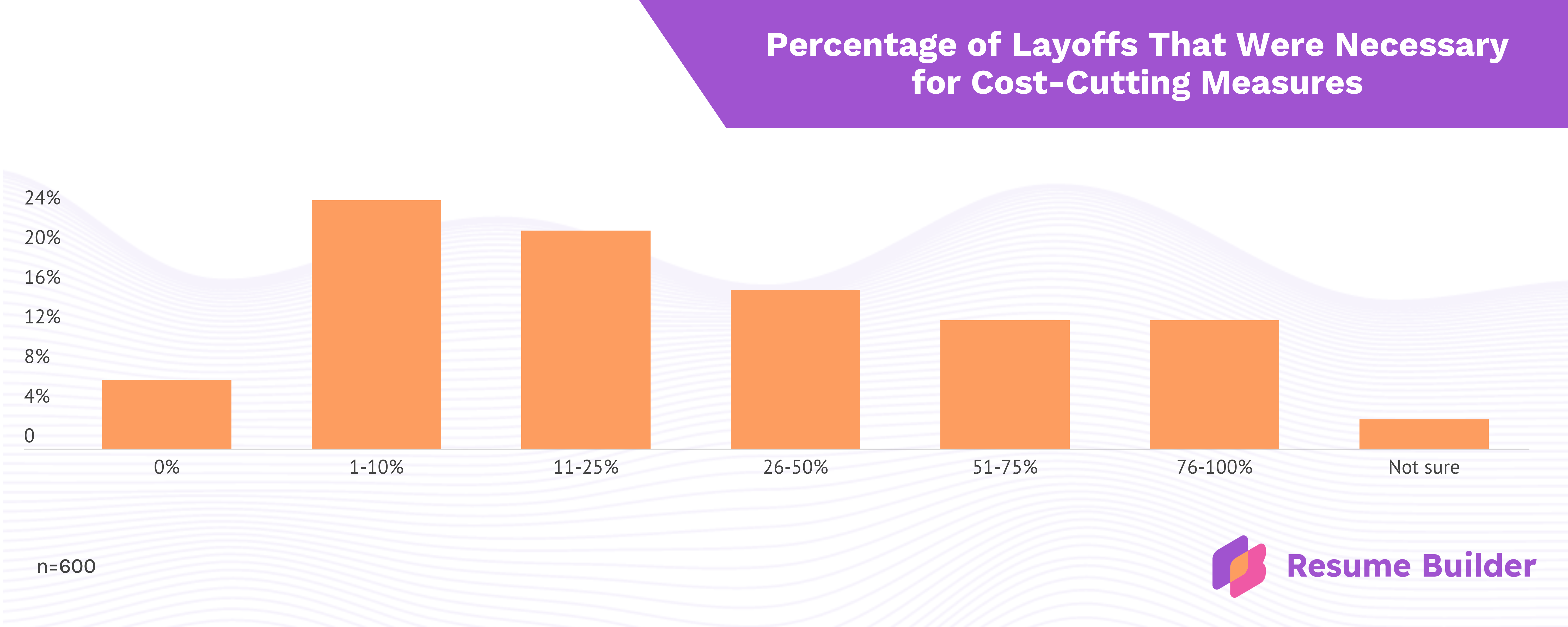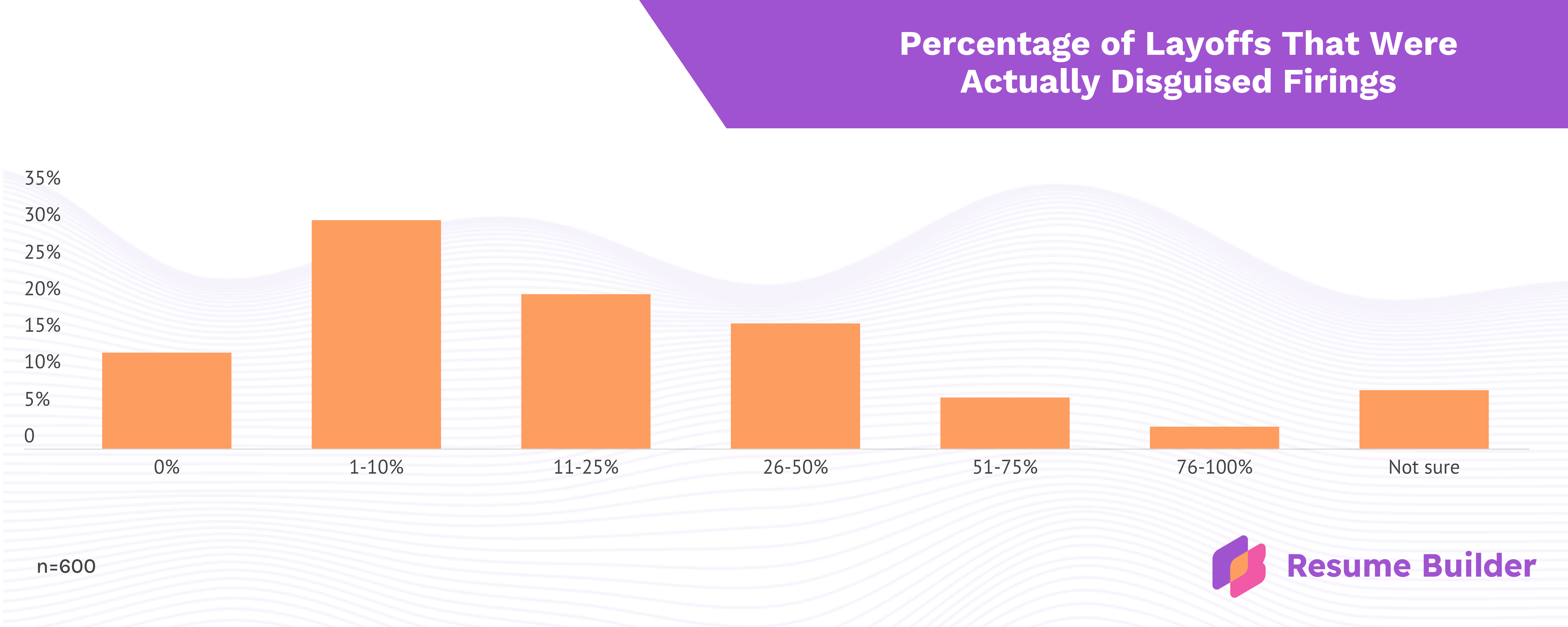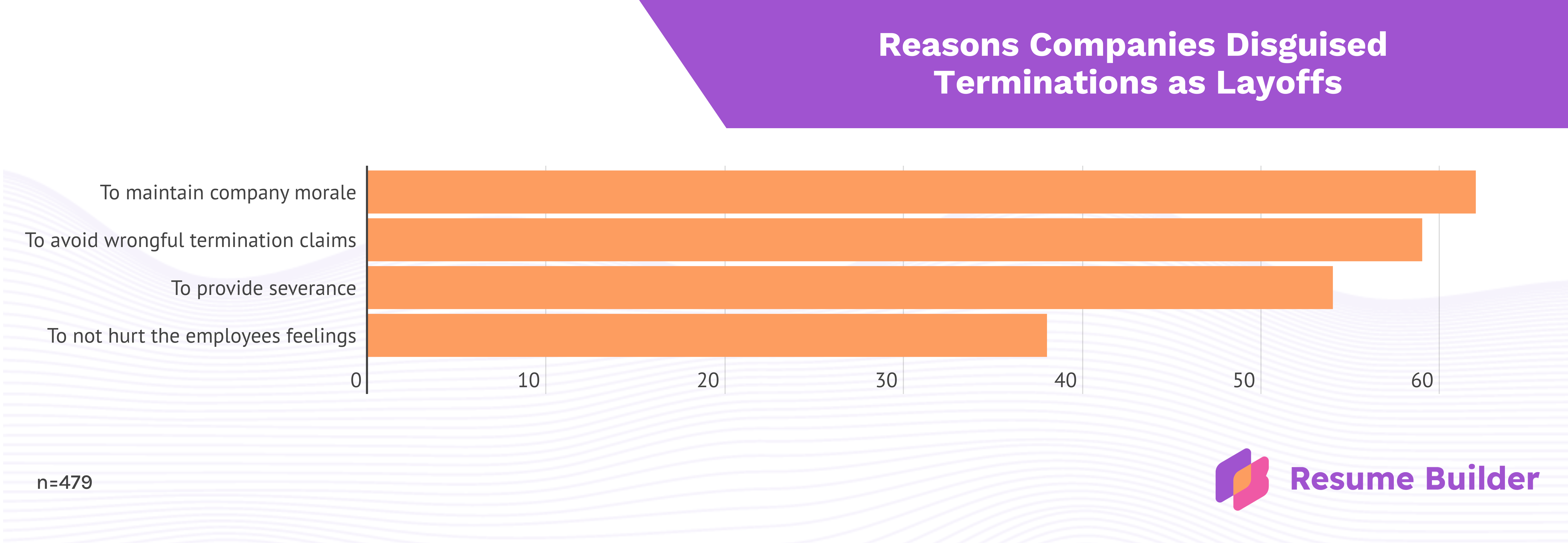Companies sometimes disguise performance-based terminations as layoffs to avoid conflicts. To find out how prevalent this strategy was in the past year, in July, ResumeBuilder.com surveyed 600 business leaders involved in decisions to terminate employees at companies that had layoffs in the past year.
Key findings:
- Half of business leaders admit that 75% or more of the layoffs at their company in the past year weren’t necessary for cutting costs
- 63% of companies have laid off employees in the past year
- 80% say their company chose to layoff an employee instead of firing them
- Top reason for hiding termination decisions behind layoffs is to maintain company morale
- 31% of business leaders surveyed say performance is always a factor in layoff decisions
More Than Half of Business Leaders Say Majority of Layoffs Weren’t Necessary for Cutting Costs at Their Company
When asked about the necessity of layoffs for cutting costs, 7% of business leaders note that none (0%) of their company’s layoffs were necessary for cost-cutting. A quarter (25%) indicate that 1% to 10% of the layoffs were essential, while 22% estimate the necessity at 11% to 25%.
Additionally, 16% say that 26% to 50% of the layoffs were necessary, 13% say 51% to 75% were, and approximately 13% note that 76% to 100% of the layoffs were crucial for cost reduction. About 3% of respondents were unsure about the necessity of the layoffs for cutting costs.

“A disturbing trend is emerging where organizations reduce their workforce under false pretenses. Many companies implement strict return-to-office (RTO) policies to indirectly encourage employees to leave voluntarily, thus avoiding the need for layoffs or terminations.
“This lack of transparency is further highlighted by our survey, which indicates that numerous companies use layoffs as a cover for firing employees who are underperforming. Instead of addressing performance issues directly, these companies cite cost reductions as the reason for layoffs, obscuring their true motives.
“Such practices contribute to the growing erosion of trust between employers and employees,” says Resume Builder’s Chief Career Advisor Stacie Haller.
8 in 10 Companies Used Layoffs To Terminate Employees They Wanted to Fire
When asked if their company had chosen to lay off an employee instead of firing them in the past year, 80% of business leaders confirmed that this practice occurred, while 13% stated it did not, and 7% were unsure.
Regarding the extent to which layoffs were actually disguised firings at companies, 31% of business leaders say that 1% to 10% of layoffs at their company fell into this category. Additionally, 21% say 11% to 25% did, 17% indicate 26% to 50% did, 7% report 51% to 75% did, and 3% state 76% to 100% did.

Maintaining company morale tops reasons for disguising firings as layoffs
According to business leaders surveyed, the main reasons their company disguised performance-based terminations as layoffs included maintaining company morale (62%), avoiding wrongful termination claims (59%), and providing severance (54%). Additionally, 38% cited the desire to avoid hurting the employee’s feelings.
The reasons for actually wanting to fire these employees were poor performance (78%), violation of company policies (46%), and attendance issues (45%).

3 in 10 Managers Say Performance Is Always a Factor in Layoffs
According to the survey, 31% of business leaders indicate that performance always influences their layoff decisions, while 51% say it often does. Additionally, 15% state that performance sometimes plays a role, while 3% mention it rarely does, and less than 1% say performance never factors into their layoff decisions.
“Managers need more training on how to work with employees to avoid termination and how to carry out firings in a legal, ethical, and professional manner. Particularly with younger managers who are relatively new to their roles, layoffs may seem like the easier option without the potential legal repercussions that a firing may bring. Managers need more training to handle performance issues directly and transparently, fostering a more ethical and effective approach to workforce management,” says Haller.
More than half of managers are willing to give former low-performing employees good recommendations
When it comes to providing recommendations for laid-off employees with poor performance, opinions are more divided. About 21% of business leaders say they are very likely to give good recommendations, while 34% are somewhat likely to do so. However, 37% are not very likely to provide positive recommendations, and 8% are not likely at all.
Methodology
This survey, launched on July 22, 2024, was commissioned by ResumeBuilder.com and conducted online by the polling platform Pollfish. Overall, 600 business leaders completed the survey.
To qualify for the survey, all participants had to be over 25, have a household income of at least $75,000, have an education level above high school, have a manager-level role or higher, and work at a company with more than 10 employees.
Respondents also had to indicate they are involved in termination decisions and their company has had layoffs in the past year via screening questions.
For all media inquiries, contact [email protected].
